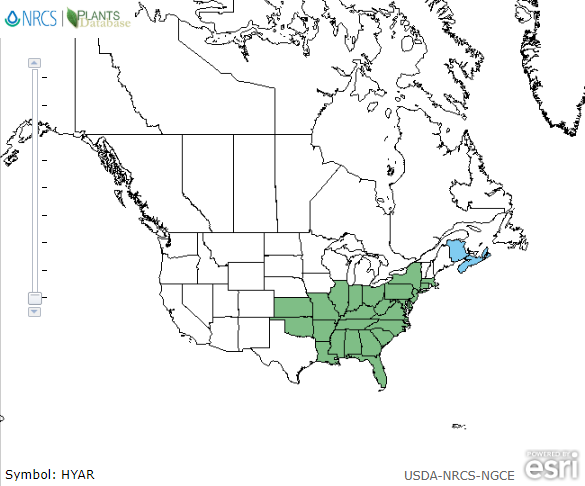Plant of the Week
 Hydrangea arborescens range map. USDA PLANTS Database.
Hydrangea arborescens range map. USDA PLANTS Database.
 Plant with flowers (21 June 2013) Photo by David D. Taylor.
Plant with flowers (21 June 2013) Photo by David D. Taylor.
 Close up of flowers (21 June 2013) Photo by David D. Taylor.
Close up of flowers (21 June 2013) Photo by David D. Taylor.
Wild Hydrangea (Hydrangea arborescens L.)
By David Taylor
Wild hydrangea is a member of the Hydrangeaceae, the Hydrangea family. Species in this family range from small to large shrubs to woody vines. A number of common ornamental shrubs are in the family including sweet mock orange (Philadelphus coronarius) and panicle hydrangea (H. paniculata). In older manuals and sources, wild hydrangea is put in the Saxifragaceae, the Saxifrage family.
This shrub is 1 to 3 meters (3.3 to 9.8 feet) tall, usually on the smaller than larger. One to many somewhat weak stems arise from the crown. Leaves are opposite, 7 to 15 centimeters (2 3/4 to 6 inches) long by 3.8 to 8 centimeters (about 1.5 to 3 inches) wide. Leaves are thin, toothed, green on top and paler underneath. Flowers are borne in 5 to 12 centimeters (2 to 4 3/4 inches) wide clusters (inflorescences) at tips of branches. Clusters may contain more than 100 flowers White 4 to 5-petaled flowers are small, only about 2 millimeters (0.08 inches) wide. Sometimes large sterile flowers are produced at the edge of inflorescence, which serve to attract pollinators. Fruits are tiny, many-seeded capsules.
Wild hydrangea is usually found in mesic forest, often along streams or in rocky areas, but also grows in drier areas. It is usually in at least partial shade. It is found from New York and Massachusetts west through Illinois and Missouri, south to Louisiana and Florida, and in Kansas and Oklahoma. It is also known from New Brunswick and Nova Scotia.
This species flowers in June to early August depending on the part of the country in which it is found. Bees, wasps, and beetles are strongly attracted to the flowers. A similar species, H. cinerea, Ashy Hydrangea, mostly in the Appalachian Mountains, has the underside of the leaves whitened or gray with dense hairs.
This species is sold under one or more cultivar names in the nursery trade.


